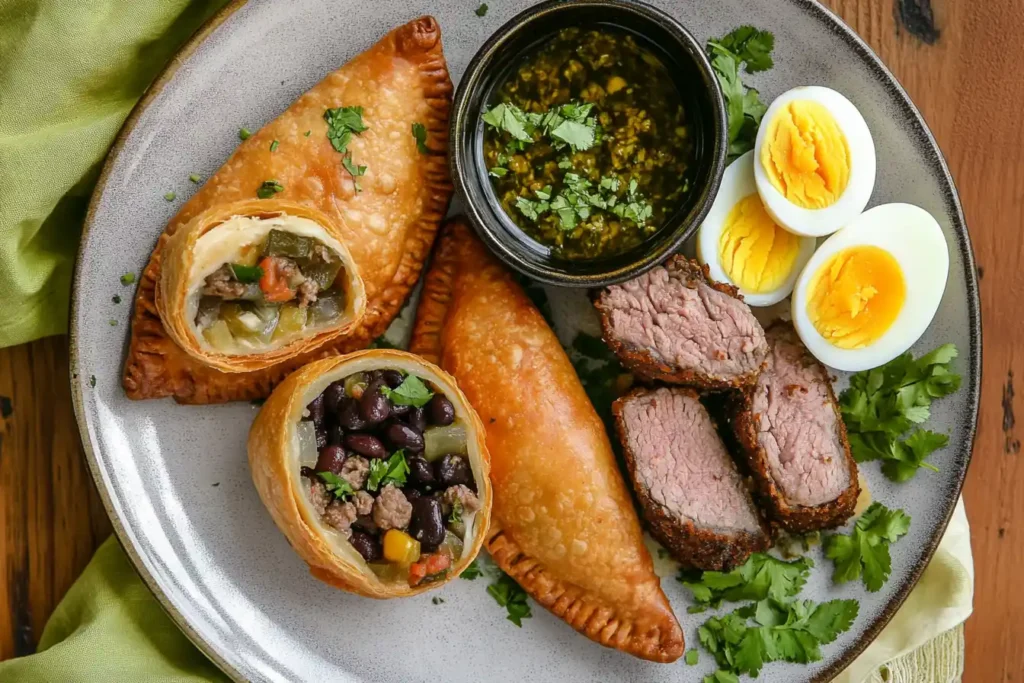Empanadas are a beloved culinary treasure across Latin America, but what is the difference between Argentina and Venezuela empanadas? These two nations, with rich culinary traditions, offer unique takes on this savory pastry, reflecting their cultural diversity and local ingredients. In this article, we’ll explore the fascinating differences in preparation methods, ingredients, regional flavors, and cultural significance of empanadas from these two countries. Let’s dive in and uncover what makes each type of empanada distinct!
Overview of Empanadas and Their Cultural Significance
What Are Empanadas?
Empanadas are a type of turnover or pastry, typically filled with savory or sweet ingredients, folded over, and sealed along the edges. These delectable hand pies trace their origins to Spain, but they’ve evolved dramatically across Latin America, adapting to regional ingredients and preferences.
From the baked empanadas of Argentina to the fried empanadas of Venezuela, these pastries have become a staple dish that embodies both simplicity and versatility. People cherish empanadas for their portability and satisfying flavor, whether they enjoy them as a quick snack or a main course.
The Cultural Importance of Empanadas in Latin America
Empanadas aren’t just food—they’re a celebration of heritage. In Argentina, families and friends often enjoy empanadas during gatherings, festivals, and national holidays. Different provinces boast their own signature styles, making each bite a flavorful exploration of the country’s diversity.
In Venezuela, empanadas are a breakfast favorite, commonly found at roadside stalls or bustling markets. They reflect the country’s culinary creativity, with fillings that mirror its vibrant culture and tropical ingredients.
These turnovers also serve as a unifying dish, transcending social and economic divides. Whether it’s a casual street food vendor or a high-end restaurant, empanadas remain a symbol of warmth, community, and shared traditions.
With this introduction and overview, we’ve set the stage for understanding the unique differences between Argentine and Venezuelan empanadas. Stay tuned as we dig deeper into their distinct cooking methods, dough, fillings, and more in Part 2!
Key Differences in Argentina and Venezuela Empanadas
Cooking Methods That Define Argentina and Venezuela Empanadas

One key difference between Argentina and Venezuela empanadas lies in their cooking methods. Baking gives Argentine empanadas their signature golden, light, and flaky crust. This method allows the filling’s flavors to shine through while maintaining a healthier profile compared to frying.
In contrast, frying gives Venezuelan empanadas their signature crispy texture and rich flavor. The frying process not only enhances the dough’s crunchiness but also imbues it with a satisfying, rich flavor that complements the tropical fillings often used.
To explore more about the frying technique and other Venezuelan recipes, check out this comprehensive guide to Venezuelan empanadas.
Dough Differences Between Argentina and Venezuela Empanadas
The type of dough used is another key feature that sets these empanadas apart. Argentine empanadas rely on a wheat flour dough, which creates a smooth, malleable texture ideal for shaping into intricate folds or crimped edges. Traditional Argentine dough often incorporates butter or lard, which contributes to its tender, melt-in-your-mouth quality.
Meanwhile, Venezuelan empanadas use a corn flour dough, derived from pre-cooked cornmeal. This gives the dough its distinctive yellow hue and a slightly grainy texture. The corn base also provides a unique, earthy flavor that complements the fried exterior.
For a deep dive into the nuances of corn-based empanadas, visit this article comparing Colombian and Venezuelan empanadas.
Traditional Fillings in Argentine and Venezuelan Empanadas

The filling is where these empanadas truly come alive. However, Argentine empanadas often feature a simple yet savory filling. Popular choices include beef, flavored with paprika, cumin, and onions, or ham and cheese. In addition, other regions incorporate hard-boiled eggs or olives for an added layer of flavor.
On the other hand, Venezuelan empanadas embrace bold and tropical combinations. Iconic fillings like pabellón, a mix of shredded beef, black beans, and plantains, showcase the country’s culinary creativity. Cheese empanadas, filled with soft, oozing white cheese, are another popular favorite.
Regional Variations
Even within each country, empanadas exhibit incredible diversity. In Argentina, provinces such as Salta and Tucumán are famous for their distinct empanada recipes, often with spicy touches or unique folding techniques.
In Venezuela, regional differences also abound. Coastal areas lean heavily on seafood fillings, while inland regions favor heartier meat options. Exploring these local styles is akin to a culinary road trip through each nation.
Ingredients That Define Argentina and Venezuela Empanadas
Staple Ingredients in Argentina Empanadas
Argentine empanadas are celebrated for their simple yet flavorful ingredients, which combine tradition and taste in every bite. At the heart of these pastries are their carefully chosen seasonings. Cumin and paprika are staples, giving the fillings a warm, slightly smoky flavor that complements the richness of the meat, particularly beef. These spices aren’t overpowering but work harmoniously to enhance the natural taste of the ingredients, creating a balance of subtle heat and depth.
The dough is equally important in defining the flavor profile of Argentine empanadas. Made with wheat flour and often enriched with butter or lard, it has a tender, melt-in-your-mouth quality that adds to the overall richness. This soft yet sturdy dough forms the perfect shell to hold the fillings, ensuring every bite is satisfying without being heavy.
What truly sets Argentine empanadas apart are the small yet impactful additions to the fillings. Many recipes incorporate hard-boiled eggs and green olives, which provide contrasting textures and a salty-sweet balance. The eggs add creaminess, while the briny tang of olives cuts through the richness of the meat. In some regions, raisins are included for a touch of sweetness, further emphasizing the balance of flavors.
Key Ingredients in Venezuelan Empanadas
Venezuelan empanadas owe their unique flavor to tropical ingredients and a corn-based dough. Precooked corn flour, such as Harina P.A.N., is a cornerstone of the recipe, resulting in a distinctive taste and texture.
Fillings like plantains, black beans, and cheese reflect the country’s rich biodiversity. Additionally, many recipes incorporate aji dulce, a sweet chili pepper that adds depth to the empanadas without overwhelming heat.
Cultural and Social Contexts
Empanadas as a Street Food
Empanadas have earned their place as one of Latin America’s most popular street foods, especially in Argentina and Venezuela. In Argentina, empanadas are commonly found in bustling ferias (markets) and street-side kiosks. These baked delights are perfect for on-the-go snacks, offering a portable and flavorful solution for busy lifestyles.
Venezuelan empanadas, on the other hand, are often sold fresh and hot by street vendors, their fried shells crisp and inviting. Locals frequently enjoy them as a breakfast treat, paired with a cup of coffee or freshly squeezed juice. This accessibility makes them a staple of everyday Venezuelan life, reflecting a shared love for food that’s both simple and satisfying.
Empanadas in Family and Social Gatherings
Empanadas also play a central role in family and social settings. In Argentina, they are a comfort food often shared during Sunday lunches or festive celebrations like Independence Day. Each province adds its twist, making gatherings a chance to showcase regional culinary pride.
In Venezuela, empanadas are a favorite choice for casual get-togethers or celebrations. They’re often served alongside dipping sauces like guasacaca (a tangy avocado sauce) or spicy salsa, encouraging communal enjoyment. The act of preparing and sharing empanadas fosters a sense of togetherness, reinforcing their status as more than just food—they’re a social ritual.
For more Venezuelan food inspiration, check out this article on Reina Pepiada.
Comparing Taste and Texture
Flavor Profiles: Subtle vs. Bold
One of the most noticeable answers to What is the difference between Argentina and Venezuela empanadas? lies in their flavor profiles. Argentine empanadas emphasize balanced and subtle flavors. The fillings are often mildly spiced, allowing the natural taste of ingredients like beef, onions, or olives to stand out.
In contrast, Venezuelan empanadas boast bolder, more tropical flavors. The sweetness of plantains, the richness of black beans, and the tanginess of white cheese create a vibrant, multi-layered taste. These combinations often result in a richer, heartier experience.
Textural Variations
Texture is another key differentiator between the two. Argentine empanadas, with their baked preparation, are typically flaky and tender. The thin, pliable dough is soft yet sturdy enough to hold a variety of fillings without crumbling.
On the other hand, Venezuelan empanadas have a crunchy exterior due to their fried dough. The cornmeal base creates a slightly denser, coarser texture that contrasts beautifully with their moist, flavorful fillings. This unique textural balance adds to their appeal.
FAQ Section
What is the difference between Argentina empanadas and Venezuelan empanadas?
Argentine and Venezuelan empanadas differ in cooking methods, dough, and fillings, reflecting each country’s culinary heritage. Argentine empanadas are typically baked, resulting in a flaky, tender crust that enhances the natural flavors of the savory fillings. The wheat flour dough is soft and neutral, serving as an ideal base for ingredients like spiced beef, chicken, or ham and cheese. Additions such as green olives and boiled eggs create a balanced mix of sweet and salty flavors, with regional variations introducing unique touches like potatoes or spicier fillings.
Venezuelan empanadas are fried, giving the cornmeal dough a golden, crispy exterior and a heartier texture. Made from pre-cooked corn flour, the dough has a slightly sweet, earthy flavor and vibrant yellow hue. Fillings include plantains, black beans, and queso blanco (white cheese), offering bold and tropical flavors. Iconic combinations like pabellón criollo—shredded beef, black beans, plantains, and cheese—highlight Venezuela’s rich culinary diversity, making their empanadas hearty and flavor-packed.
Which country makes the best empanada?
Determining which country makes the best empanada is a matter of personal preference, and it largely depends on what flavors and textures you enjoy. Argentine empanadas are perfect for those who prefer subtle, well-balanced flavors wrapped in a light, flaky crust. They’re a reflection of Argentina’s Spanish and Italian influences, offering a sense of comfort and tradition.
Venezuelan empanadas, with their bold, tropical flavors and crunchy fried exterior, cater to those who enjoy heartier, more robust dishes. Their use of cornmeal dough and flavorful fillings reflects Venezuela’s indigenous roots and love for rich, satisfying meals.
Ultimately, both versions have their merits, and the “best” empanada may simply be the one that satisfies your cravings at the moment!
What makes each country’s empanadas different?
The differences between these empanadas stem from their preparation techniques and cultural influences. Argentina’s baked empanadas highlight the country’s Spanish and Italian culinary roots, focusing on light, delicate textures and mild, savory flavors. The wheat-based dough is easy to shape, making it versatile for creating empanadas with intricate folds or crimped edges, a hallmark of Argentine craftsmanship.
Venezuelan empanadas, by contrast, reflect the country’s tropical ingredients and indigenous cooking traditions. The cornmeal dough is hearty and naturally gluten-free, making it a unique alternative to wheat-based pastries. The frying process not only adds crunch but also enhances the bold flavors of the fillings, which often include sweet and savory combinations inspired by Venezuela’s diverse agriculture and culinary creativity.
What are Argentina empanadas?
Argentina empanadas are baked pastries crafted from wheat flour dough, filled with savory ingredients, and often enjoyed as appetizers, snacks, or even main courses. Traditional fillings include spiced beef, chicken, or ham and cheese, seasoned with classic Argentine spices like cumin and paprika. The addition of green olives and boiled eggs lends these empanadas a unique texture and depth of flavor.
What sets Argentine empanadas apart is their regional diversity. For example, empanadas from Tucumán are small and spicy, while those from Buenos Aires are larger and milder in flavor. Each region takes pride in its unique recipe, making Argentine empanadas a delicious exploration of the country’s rich culinary heritage.
Conclusion and Final Thoughts
Summarizing the Key Differences
To answer the question What is the difference between Argentina and Venezuela empanadas?, it’s clear that each country has its unique approach. Argentina offers baked empanadas with flaky wheat dough and savory fillings, while Venezuela brings fried empanadas with crispy cornmeal dough and tropical-inspired ingredients. These variations reflect their culinary traditions and local tastes.
The Cultural Unity in Culinary Diversity
Despite their differences, empanadas from Argentina and Venezuela share a common purpose: to bring people together. They celebrate cultural identity, showcase regional flavors, and connect families and friends through shared meals. Each bite is a testament to the creativity and diversity of Latin American cuisine.
For more delicious recipe ideas and culinary comparisons, explore other articles on Magnetic Recipes. Whether baked or fried, empanadas are a flavorful journey worth savoring.

